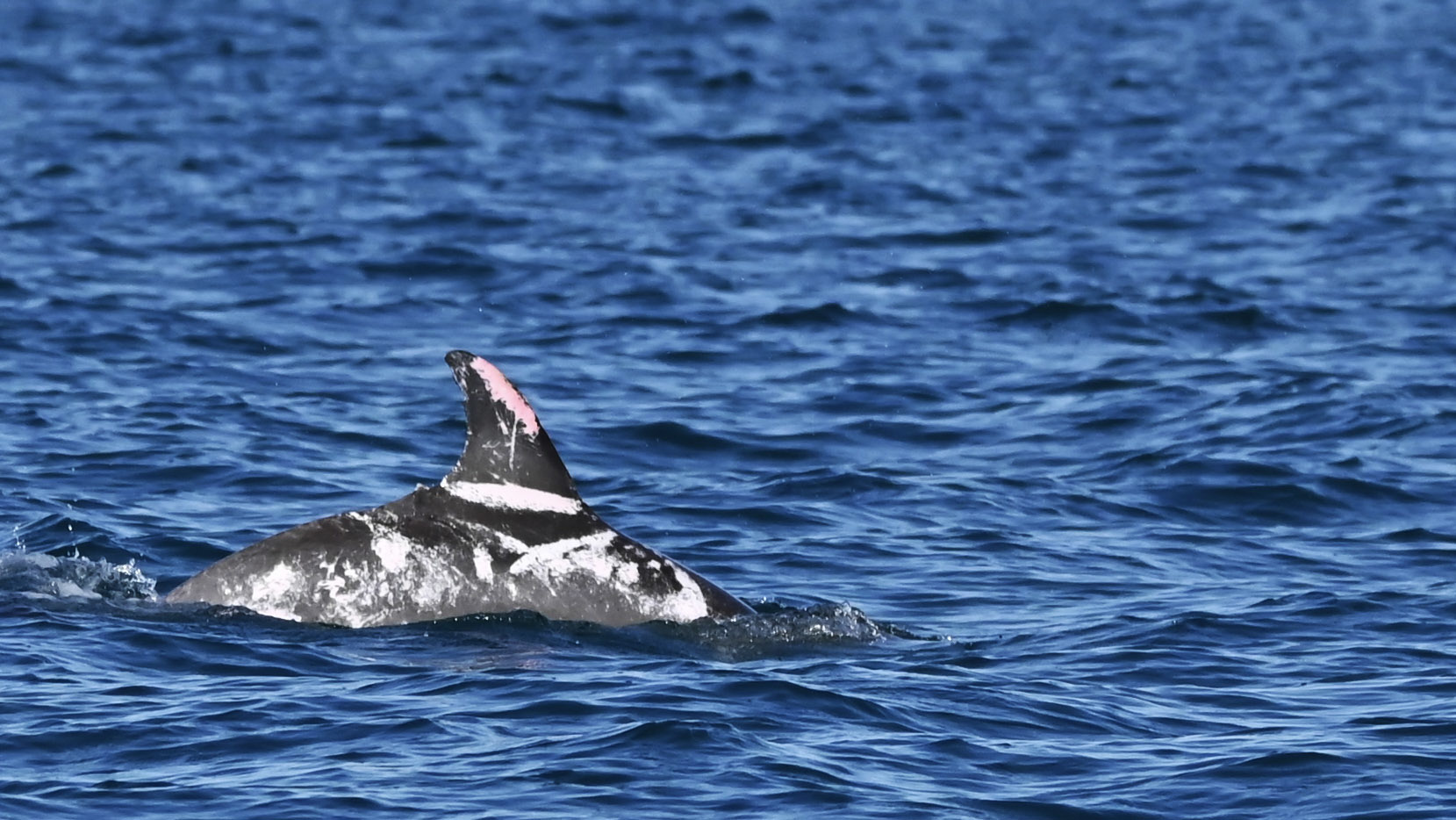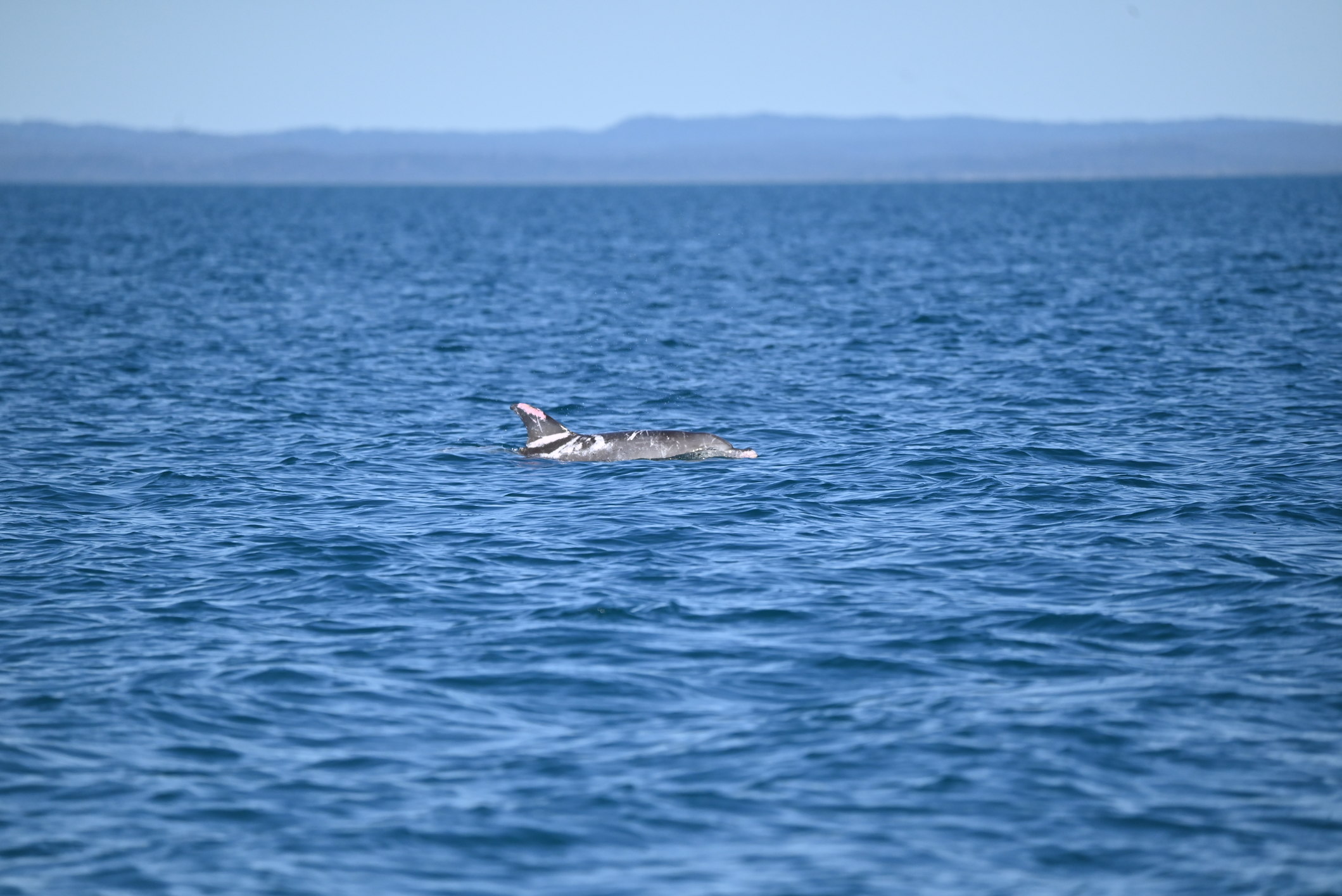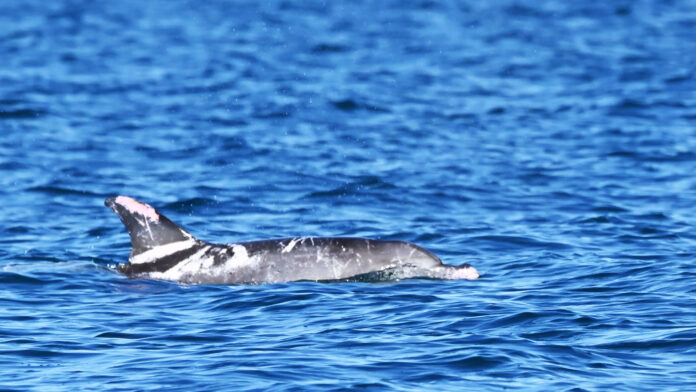An incredibly rare dolphin has been captured on camera off the Queensland coast, during a University of the Sunshine Coast study.
With its patchy black-and-white colouring, it is the first dolphin with ‘piebaldism’ to be photographed in Australian waters. Evidence of dolphins with the condition has only been recorded six times worldwide and twice in the southern hemisphere.
The striking mammal caught the attention of UniSC researchers after it leapt out of the water near their research vessel, as they surveyed Hervey Bay as part of a four-year project investigating dolphin connectivity in South-East Queensland.
Study co-supervisor and UniSC behavioural ecologist Dr Alexis Levengood hailed the sighting.
“It’s an exciting discovery as, to date, there are no documented sightings of any atypically coloured dolphins in Australian waters,” she said.
“There have however been a few sightings of atypical whales.
“One of these is a well-known albino humpback whale called ‘Migaloo’, first observed in Byron Bay in the early 1990s and whose all-white status was confirmed from a sighting in Hervey Bay one year later.
“Piebaldism is similar to albinism and leucism, where the animals typically have white skin, feathers or fur, whereas piebaldism is a partial loss of pigmentation so the individuals show this patchy colouration.”

The discovery was documented recently in the scientific journal Aquatic Mammals.
Lead author Georgina Hume, who is researching South-East Queensland’s dolphins as part of her UniSC doctoral studies, said as soon as they saw the adult bottlenose, nicknamed ‘Speckles’, they knew they had found something special.
“It was swimming with a group of five other dolphins about 16km off Hervey Bay’s Scarness Beach and we noticed it straight away as it had such strange colouration compared to the others,” Ms Hume said.
“Speckles leapt out of the water three times in an upright, vertical position, while the rest of the group travelled in a ‘porpoising’ movement,” she said.
“This allowed us to get a very clear look at its underside which had many white areas, along with white stripes across its dorsal and lateral sides.”
Help us deliver more news by registering for our FREE daily news feed. All it requires is your name and email at the bottom of this article.
It also had a distinctly marked dorsal fin that had not previously been seen in the research team’s photo-identification catalogue.
“The clear identification of near-symmetrical white patches and the overall ‘healthy’ appearance of Speckles helped eliminate the possibility that these patches are due to potential disease or stranding-related sunburn,” she said.
The researchers set about finding what caused the strange skin discolouration, including searching for other documented cases worldwide.
The literature shows piebald occurrences in dolphins are rare, with only 24 reported individuals.
Of these, there is photographic evidence for only six individual cases – in Mexico, the Black Sea, Brazil and the Strait of Gibraltar.
Apart from a healed shark bite on its right side, the researchers say Speckles was a healthy size, suggesting its skin condition has not hindered its survival to date.
As the research team continues its quest to fill gaps on the ecology, genetics, behaviour and health of dolphins in South-East Queensland, they hope to find Speckles again to better understand its role in the population.

Dr Levengood said further sightings with high-quality images coupled with genetic sampling of the dolphin – whose sex is still to be determined – would allow confirmation of the genetic mutation that has occurred to cause its atypical skin.
“We also recommend genetic sampling of both common bottlenose dolphins and Indo-Pacific bottlenose dolphins in and surrounding Hervey Bay, to assess the population genetics and relatedness of individuals that might be influencing atypical cetacean skin pigmentation,” she said.
The researchers say their four-year study – spanning from Caloundra to Hervey Bay – is the first of its kind.
Ms Hume said it was currently unknown how dolphin species in the South-East Queensland region were connected, and if some populations were being subjected to higher threats than others, particularly those found outside the protected marine parks.
“Research in South-East Queensland has mainly been centred on Moreton Bay. The last study carried out in Hervey Bay was more than 15 years ago and it only focused on one species of dolphin,” she said.
“And prior to this, no one has studied the dolphins present on the Sunshine Coast – an area that links two Marine Parks but is currently unprotected.”
As well as determining what dolphin species are present, the study is investigating their distribution, how they socially interact and their genetic connectivity.
Researchers are also studying shark bite scars on the marine mammals to gauge the threat of natural predators.
Funding support for the study was provided by UniSC, Fraser Coast Tourism and Event and the Oceania Project.
Ms Hume has also received two grants – the Holsworth Wildlife Research Endowment and the Ethyl Mary Read Research Grant – to support her doctoral research.
Do you have an opinion to share? Submit a Letter to the Editor at Sunshine Coast News via news@sunshinecoastnews.com.au. You must include your name and suburb.





